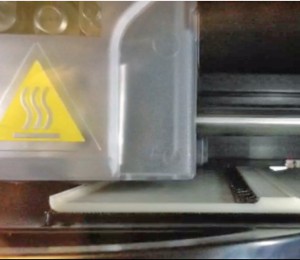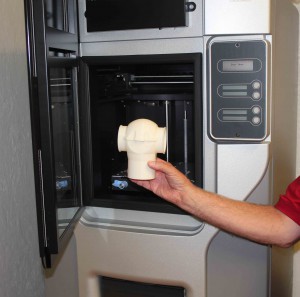One of the newest tools utilized by Hog Slat’s engineering group is a 3D printer. About the size of a small refrigerator, the 3D printer generates plastic prototype parts from computer generated 3D models.
A member of Hog Slat’s engineering group, Andrew Mitchell took a few minutes to show us how it worked.

“Here’s a feed line drop adaptor we designed for the Grow-Disk™ system,” explained Andrew as he pulled up a 3D model on his computer screen. “We needed to develop a model that would work on both metal and plastic tubes. Since these tubes have slightly different diameters, we wanted to test the fit before proceeding with molding.”
 The cube in the screen represents the printer’s chamber, and the white image is a digital model. The program divides the object into digital cross-sections and the printer builds the object in layers. The printer makes multiple passes spraying very thin layers of plastic until the final shape is complete.
The cube in the screen represents the printer’s chamber, and the white image is a digital model. The program divides the object into digital cross-sections and the printer builds the object in layers. The printer makes multiple passes spraying very thin layers of plastic until the final shape is complete.
 “You can almost compare the printer to a giant glue gun that accurately places liquid plastic down in precise layers,” Andrew said, “The process can take from several hours up to several days depending on the size of the item. The maximum size part we can print is 10” x 10” x 12” tall”
“You can almost compare the printer to a giant glue gun that accurately places liquid plastic down in precise layers,” Andrew said, “The process can take from several hours up to several days depending on the size of the item. The maximum size part we can print is 10” x 10” x 12” tall”
 “We were able to take the prototype drop adaptor and test it on both the metal and plastic feed tubes. We made a few small dimensional adjustments and proceeded with complete confidence that the final part would fit as we intended.”
“We were able to take the prototype drop adaptor and test it on both the metal and plastic feed tubes. We made a few small dimensional adjustments and proceeded with complete confidence that the final part would fit as we intended.”












 Україна
Україна Méjico
Méjico


